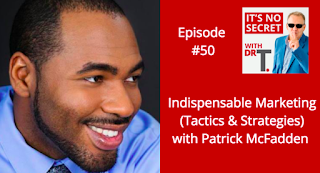129 - Income Producing Equipment
When it comes to purchasing equipment for your business, there are two types of equipment purchases you can make. One is income producing equipment and the other is non-income producing equipment.
For example, let’s say you need to purchase eight chairs for your reception and you’re deciding between a $150 chair and a $400 chair, which means you will spend $1200 or $3200 to purchase the eight chairs. In addition to this the comfort levels of the chairs are about the same, and at first glance, they look similar as well.
This is when you need to stop, think and ask two questions:
- Will the $150 chairs be sufficient for your current needs?
- Can you use the $2000 you save elsewhere in your business?
Brand
If a $150 chair will be sufficient and serve the intended purpose why spend the extra $250 per chair, especially if it’s not going to take anything away from your brand.I know from experience that you are better off saving the $2000, or investing the $2000 towards income-producing equipment that will generate income for years to come.
Best ROI
As your business generates revenue, you can save it and earn interest, or you can reinvest your money into income-producing equipment. Ask yourself where are you going to get the best return on your investment?If you had $30,000 sitting in the bank account, earning 10% interest, you’re only getting $3000 income per year, but if you invested the same amount of money into purchasing income producing equipment, how many times would you need to use the equipment to get the same return?
When I purchased a milling machine to make orthotics for my podiatry business in 2008 it cost approximately $75,000 to set it all up. In the first year of operation, it saved my company about $120,000 in lab fees.
After taking away the costs of materials and running costs of the equipment, I got my money back in the first year, and over the next eight years, up until selling my business, I was getting up to a 150% return on my initial investment.
Borrowing
Of course, not everyone has $75,000 sitting in a bank account, so if you borrowed $75,000 at 10%, and you were getting a 100% return on your investment, it’s still a worthwhile income-producing purchase.Equipment Goals
Before you purchase new equipment, you must set equipment goals.Purchasing equipment without setting equipment goals makes no sense, and I’ve seen a lot of expensive dust collectors sitting in the corners of many businesses because no goals or outcomes were set before the equipment purchase.
So, before making any equipment purchases, you must ask yourself the following question:
How long will it take before I get my full investment back?To work this out, you need to know:
- How much you’re going to charge?
- How many times does this service/equipment need to be utilised?
What Does The Math Tell You?
A $10,000 piece of equipment being charged out at $250 per user needs to be used 40 times to get your money back, which is less than once per week. Is this realistic? What if it’s used twice per week, that would be 104 uses for the year and would generate $26,000 in gross revenue. That’s a high ROI.In my example with the milling machine, it was about saving money per use, more so than charging out a fee per use, but in the end, it works the same way.
What Is Your Marketing Strategy?
As part of your goal setting process, you should also develop a marketing strategy. You may only need to use your new equipment 40 times to get your $10,000 investment back, but how are planning to achieve this goal? What marketing tactics are you going to employ?Opportunities
Income-producing equipment should be a business priority over non-income producing equipment, and it can and should be used to set your business apart from your competition. Think about the services you currently offer and can you offer more?In my industry, there is one piece of equipment that only costs about $300 to set up, yet not every podiatrist uses it, and it can add an extra $10,000+ to the bottom line with little to no effort.
So, keep your eyes open for opportunities, and remember a clients bum will rarely tell the difference between a $150 and $400 chair, but they will notice a business that reinvests their profits into new equipment and technology that will provide a better, faster, more efficient outcome for them.
Competitors
If you can purchase something that none of your competitors is using it will set you apart from the crowd, but first, do the math, work out if it is a viable purchase, set your goal for your ROI and have a marketing strategy in place before you make the purchase.Get this right, and you’ll set yourself up for income producing equipment success.
Mentoring
Purchasing income producing equipment and developing a marketing strategy and tactics is something I have done a lot of coaching and mentoring around, so if you need help in this area, please reach out and contact me atIf you like this episode, you'll also enjoy:
Create A Buzz by Marketing EarlyiTunes Reviews
If you enjoy It’s No Secret with Dr T., please tell your friends, and if you enjoy it a lot, it will put a HUGE smile on my face if you left a review on iTunes.Reviews do two things:
- It gives social proof this show is worth checking out
- It lets the host know that people are listening and care
Newsletter
If you want to be kept up to date with my EVENTS and other activities, please sign up to my NEWSLETTER.I promise not to spam you with daily emails or tell you about all the fake clients I've helped achieve a 214% increase in business in 3-months.
My website: https://www.tysonfranklin.com
Most Recent Episode


Comments
Post a Comment